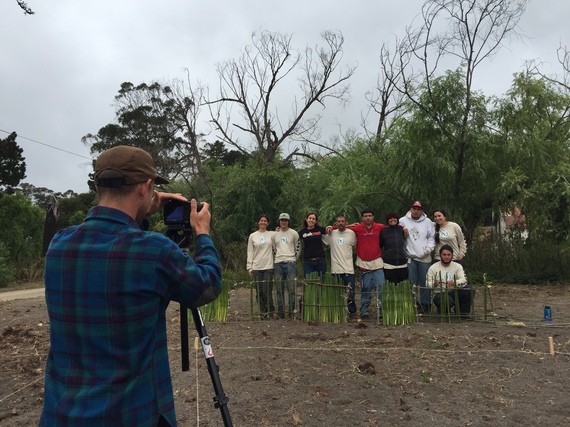 "Here and Now" would seem to direct one's attention to the present, but the past is not far behind in this inspiring film made by the Bay Area Open Space Council. (You can watch it here: https://vimeo.com/139467688 ) The past isn't even past, to paraphrase William Faulkner. The film profiles progressive partnerships between the Amah Mutsun tribal band and the Kashia Band of Pomo Indians and various land trusts. Basically the idea is to return traditional land holdings to tribal people who are yes, still here, despite centuries of disruption and dislocation.
"Here and Now" would seem to direct one's attention to the present, but the past is not far behind in this inspiring film made by the Bay Area Open Space Council. (You can watch it here: https://vimeo.com/139467688 ) The past isn't even past, to paraphrase William Faulkner. The film profiles progressive partnerships between the Amah Mutsun tribal band and the Kashia Band of Pomo Indians and various land trusts. Basically the idea is to return traditional land holdings to tribal people who are yes, still here, despite centuries of disruption and dislocation.
Not just indigenous people have been under assault for hundreds of years -- so has the ecological functioning they tended and supported. Human-caused climate change is one way to describe the result - to the extent that staid geophysicists have named our epoch the Anthropocene. Environmental theorist Timothy Morton has declared that "the end of the world has already occurred," dating the apocalypse: "It was April 1784, when James Watt patented the steam engine, an act that commenced the depositing of carbon in Earth's crust--namely, the inception of humanity as a geophysical force on a planetary scale."
But up on the Santa Cruz Mountains, on land now owned by the Amah Mutsun Land Trust, you might think as I have that no, the "end of the world" happened right here, when the Spanish made first contact with the Indians in 1769. Thus began an unravelling that yes encompasses the great transfer of carbon from ground to atmosphere, but includes the more fundamental disruption of the place of the human in nature.
As far as the end of the world goes, there's lots of evidence for it. In the ocean in front of us at Santa Cruz, the biggest marine die-off in recorded history is underway, with sea stars dying from Alaska to Baja, and this summer thousands of Cassin's Auklets fell out of the sky -- the tiny sea bird starving in record numbers from megadrought impacts exacerbated by climate change. We aren't taking care of nature. But how to do it right?
"What we're really talking about here is stewardship," Valentine Lopez, Chair of the Amah Mutsun, has told me. "We're restoring an ancient covenant with the land, fulfilling our responsibility to take care of it." The Amah Mutsun are helping to establish that cultural burning practices here resulted in a way of life definable not as hunting and gathering nor as agriculture. The California Indians lived on the land without depleting it. Precontact Native Californians pruned, tilled, coppiced, and burned the landscape; everybody got fed. Populations of wild species were enhanced and their numbers increased.
"In 2005 the elders came to me and said, we have to get back to taking care of the land. The Creator never rescinded our obligation to it." He laughed. "Can you imagine, these people with minimum wage jobs if they have one at all, who don't own any land themselves, saying we have to steward it? Now where were we going to do that?" The Sempervirens Fund has been instrumental in setting up the land trust. Among the partners helping the Amah Mutsun restore traditional knowledge and practices is Pie Ranch, near Pescadero, where a garden of traditional plants is being cultivated by younger Amah Mutsun tribal members, including Abran Lopez. In "Here and Now," Lopez gently comments that in the past, tribal partnerships with European-Americans "went the other way," but "this is a new era." Lopez puts his hand on his heart to express what his work on the land here feels like. Nancy Vail from Pie Ranch says for her, the partnership helps express "values rooted in love and justice." Amah Mutsun tribal member Nathan Vasquez says, "this is about people and nature, beyond skin color." He adds that "It is a blessing to come here and gather."
The Kashia Band of Pomo Indians were also among the first indigenous people on this coast to interact with white people from far away, at the Russian-held Fort Ross. Today the Trust for Public Land is helping get 700 acres of redwood forest back into tribal hands. Chairman Reno Franklin calls the partnership "healing for us." Franklin points out that we've culturally paid a lot of attention to endangered plants and animals, but not to the equally "endangered Indians." "Here and Now" is a bright and hopeful film, and points the way forward to healing strategies for the whole of nature, including the Homo sapiens who often forget we are part of it.
